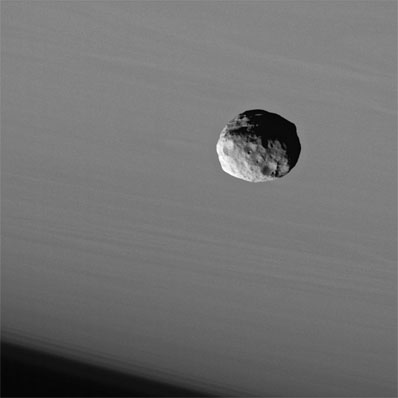Janus

Janus.

Janus, with Saturn in the background, seen by Cassini's narrow-angle camera at a distance of about 145,000 kilometers (90,000 miles) and a Sun-Janus-spacecraft angle of 62°. The image was taken using a filter sensitive to wavelengths of infrared light centered at 930 nanometers. Image scale is 871 meters (2,858 feet) per pixel.
Janus is an inner moon of Saturn. It was discovered on 15 December 1966, by Audouin Dollfus and is also known as Saturn X. It is nearly co-orbital (shares its orbit) with Epimetheus and is located between Saturn's F- and G-rings. Because Janus and Epimetheus differ in their orbital radii by only 50 kilometers, their orbital velocities are very nearly equal and the lower, faster one gradually catches up and overtakes the other. As the moons approach each other they exchange a small amount of momentum as a result of which the lower one is boosted into a higher orbit while the higher one drops to a lower orbit. This exchange of places happens about once every four years.
Although Dollfus is credited with the discovery of Janus, it is not certain whether the object he saw was Janus or Epimetheus and his observations led to a spurious orbit. (Walker discovered it independently but his telegram arrived a few hours after that of Dollfus.) Larson and Fountain determined in 1978 that there are two moons at about 151,000 kilometers from Saturn – a fact confirmed in 1980 by Voyager 1.
Janus is potato-shaped and extensively cratered, with several craters larger than 30 kilometers (19 miles), but has few linear features. Its surface looks as though it has been smoothed by some process. Like Pandora and Telesto, Janus may be covered with a mantle of fine dust-sized, icy material.
| discovery | 1966, by Audouin Dollfus |
| semimajor axis | 151,460 km (94,130 mi) |
| diameter | 193 × 173 × 137 km (120 × 108 × 85 mi) |
| mean density | 0.6 g/cm3 |
| surface gravity | 0.014 m/s2 |
| orbital period | 0.695 day (16 h 41 min) |
| orbital eccentricity | 0.007 |
| orbital inclination | 0.16° |
| axial period | synchronous |
| visual albedo | 0.5 |


